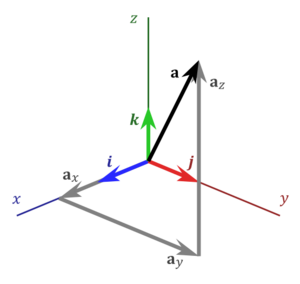Physics:Versor

In geometry and physics, the versor of an axis or of a vector is a unit vector indicating its direction.
The versor of a Cartesian axis is also known as a standard basis vector. The versor of a vector is also known as a normalized vector.
Versors of a Cartesian coordinate system
The versors of the axes of a Cartesian coordinate system are the unit vectors codirectional with the axes of that system. Every Euclidean vector a in a n-dimensional Euclidean space (Rn) can be represented as a linear combination of the n versors of the corresponding Cartesian coordinate system. For instance, in a three-dimensional space (R3), there are three versors:
- [math]\displaystyle{ \mathbf{i} = (1,0,0), }[/math]
- [math]\displaystyle{ \mathbf{j} = (0,1,0), }[/math]
- [math]\displaystyle{ \mathbf{k} = (0,0,1). }[/math]
They indicate the direction of the Cartesian axes x, y, and z, respectively. In terms of these, any vector a can be represented as
- [math]\displaystyle{ \mathbf{a} = \mathbf{a}_x + \mathbf{a}_y + \mathbf{a}_z = a_x \mathbf{i} + a_y \mathbf{j} + a_z \mathbf{k}, }[/math]
where ax, ay, az are called the vector components (or vector projections) of a on the Cartesian axes x, y, and z (see figure), while ax, ay, az are the respective scalar components (or scalar projections).
In linear algebra, the set formed by these n versors is typically referred to as the standard basis of the corresponding Euclidean space, and each of them is commonly called a standard basis vector.
Notation
A hat above the symbol of a versor is sometimes used to emphasize its status as a unit vector (e.g., [math]\displaystyle{ \hat{\bold{\imath}} }[/math]).
In most contexts it can be assumed that i, j, and k, (or [math]\displaystyle{ \vec{\imath}, }[/math] [math]\displaystyle{ \vec{\jmath}, }[/math] and [math]\displaystyle{ \vec{k} }[/math]) are versors of a 3-D Cartesian coordinate system. The notations [math]\displaystyle{ (\hat{\bold{x}}, \hat{\bold{y}}, \hat{\bold{z}}) }[/math], [math]\displaystyle{ (\hat{\bold{x}}_1, \hat{\bold{x}}_2, \hat{\bold{x}}_3) }[/math], [math]\displaystyle{ (\hat{\bold{e}}_x, \hat{\bold{e}}_y, \hat{\bold{e}}_z) }[/math], or [math]\displaystyle{ (\hat{\bold{e}}_1, \hat{\bold{e}}_2, \hat{\bold{e}}_3) }[/math], with or without hat, are also used, particularly in contexts where i, j, k might lead to confusion with another quantity. This is recommended, for instance, when index symbols such as i, j, k are used to identify an element of a set of variables.
Versor of a non-zero vector
The versor (or normalized vector) [math]\displaystyle{ \hat{\mathbf{u}} }[/math] of a non-zero vector [math]\displaystyle{ \mathbf{u} }[/math] is the unit vector codirectional with [math]\displaystyle{ \mathbf{u} }[/math]:
- [math]\displaystyle{ \hat{\mathbf{u}} = \frac{\mathbf{u}}{\|\mathbf{u}\|}. }[/math]
where [math]\displaystyle{ \|\mathbf{u}\| }[/math] is the norm (or length) of [math]\displaystyle{ \mathbf{u} }[/math]. Notice that a versor lost the units of the original vector. For instance, if we have the vector [math]\displaystyle{ \vec{u} = (0, 5, 0)\, \mathrm{m} }[/math], then [math]\displaystyle{ |\vec{u}| = \sqrt{0^2 + 5^2 + 0^2}\, \mathrm{m} = 5\, \mathrm{m} }[/math] and
[math]\displaystyle{ \hat{u} = \frac{\vec{u}}{|\vec{u}|} = \frac{(0, 5, 0)\, \mathrm{m}}{5\, \mathrm{m}} = (0, 1, 0) }[/math]
You can notice that [math]\displaystyle{ \hat{u} }[/math] is a dimensionless quantity.
This article does not cite any external source. HandWiki requires at least one external source. See citing external sources. (2021) (Learn how and when to remove this template message) |

